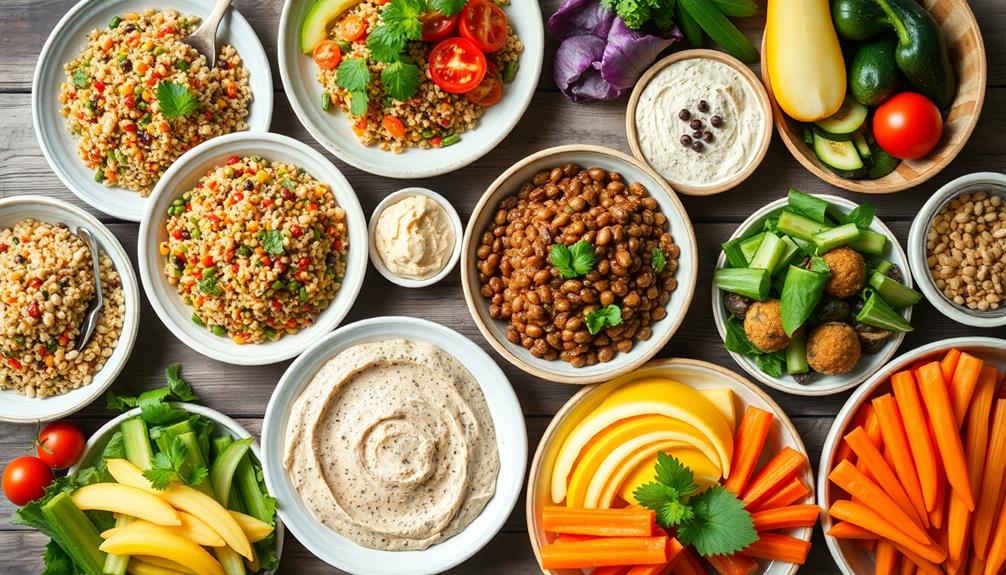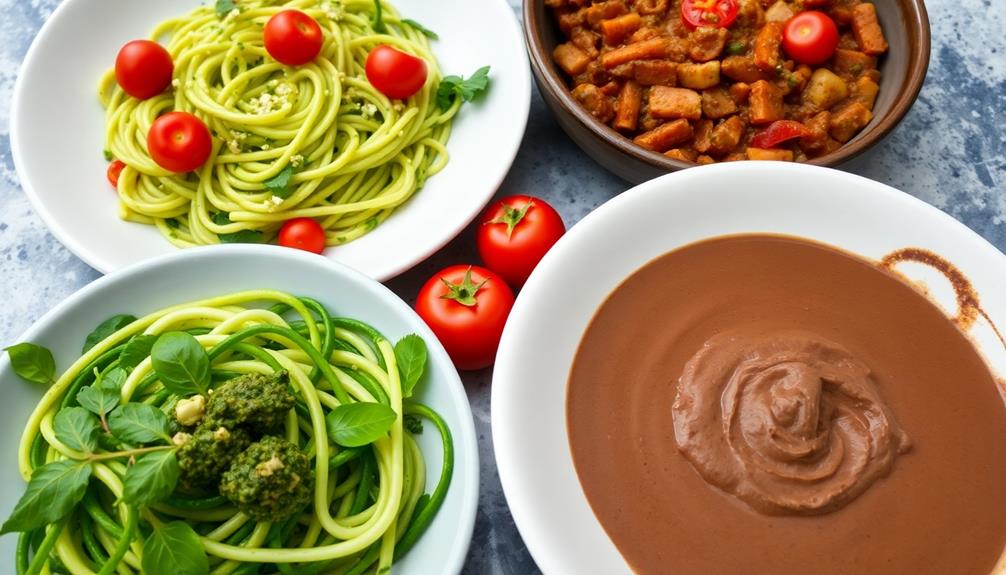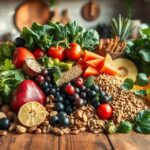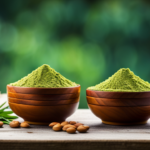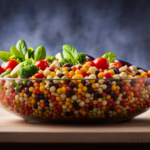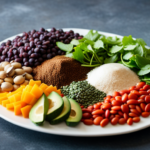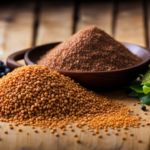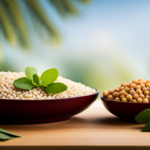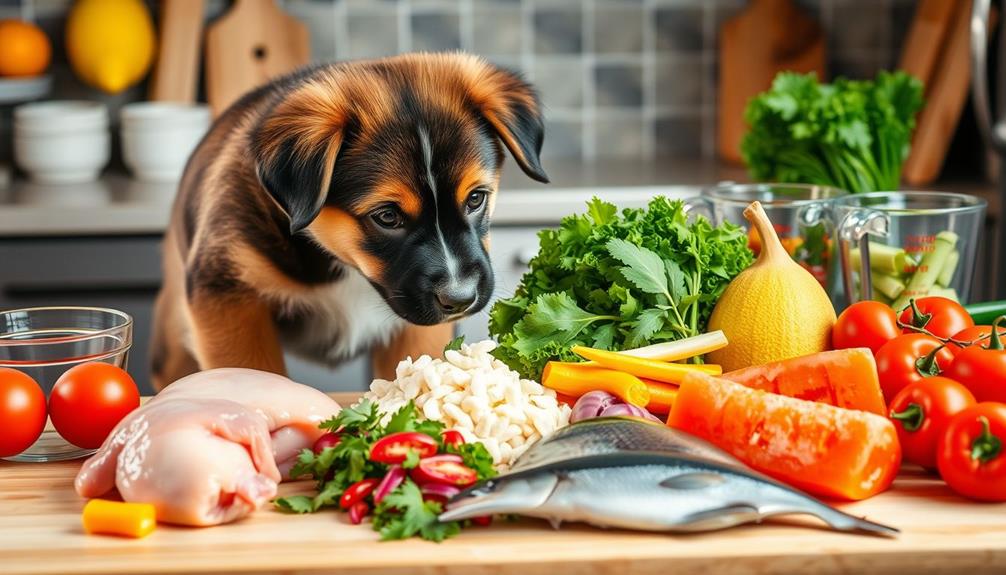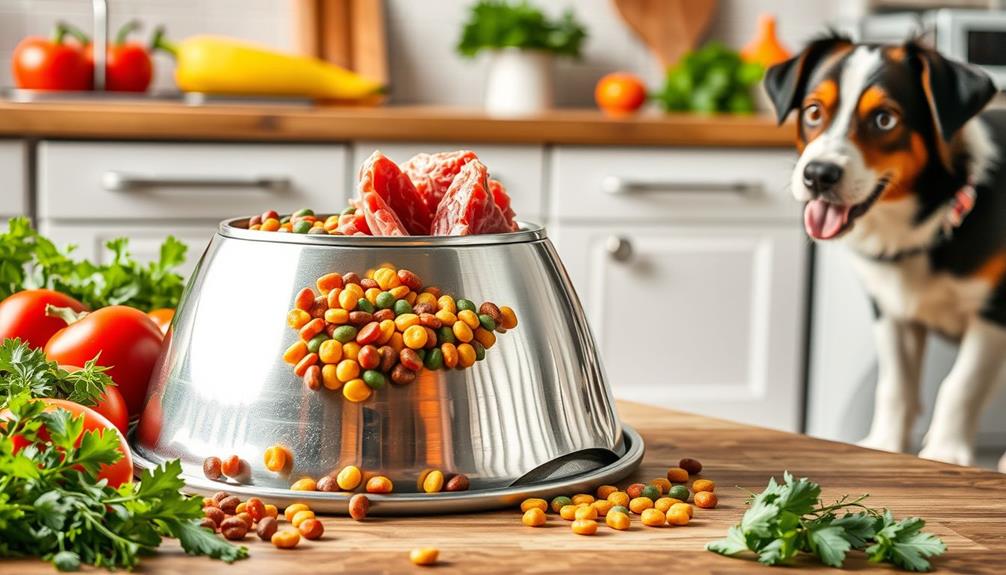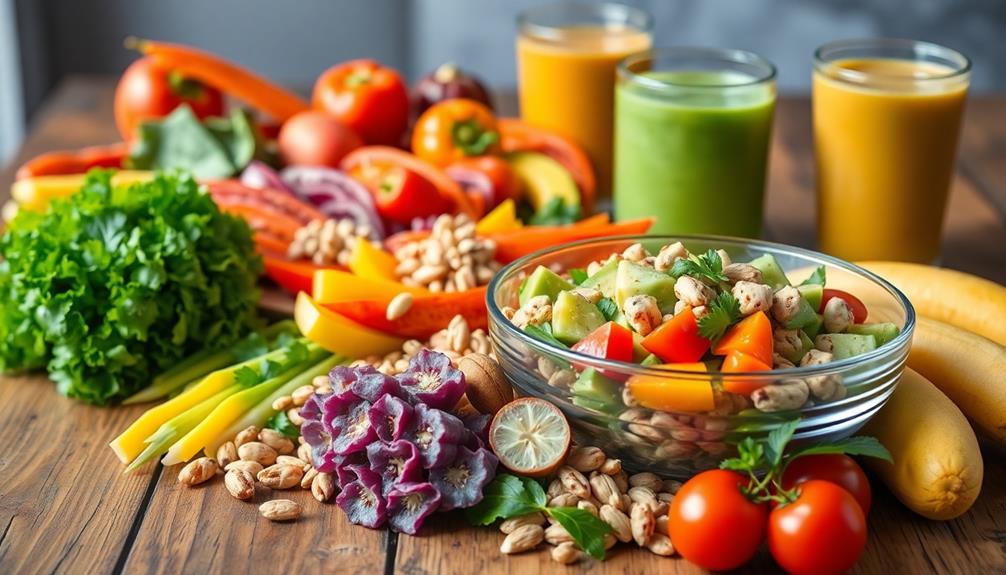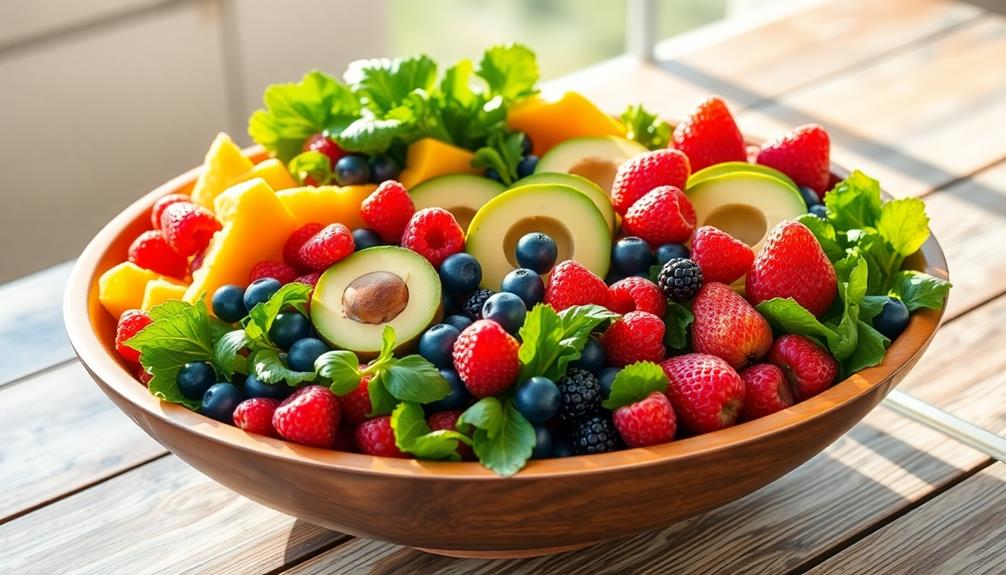You can easily boost your protein intake with high-protein raw food recipes. Start by incorporating legumes like lentils and chickpeas, along with nuts and seeds such as chia and hemp for their complete amino acid profile. Smoothie bowls with leafy greens and plant-based protein powder make a great breakfast. For snacks, try energy balls made from dates and nuts. Even raw hummus from sprouted lentils offers a nutrient-dense option. Mixing these ingredients creates delicious, satisfying meals. Stick around, and you'll uncover even more exciting recipes and tips to enhance your raw vegan journey.
Key Takeaways
- Incorporate legumes like lentils and chickpeas in recipes for a protein-rich base that supports muscle growth and digestion.
- Use nuts and seeds, such as chia and hemp, to add healthy fats and complete proteins to smoothies and energy snacks.
- Create raw hummus from sprouted lentils to enhance nutrient absorption and add flavor while boosting protein content.
- Blend leafy greens with plant-based protein powders in smoothie bowls for a nutritious and high-protein breakfast option.
- Prepare energy balls from dates, nuts, and spirulina for a delicious, protein-packed snack that's easy to make and store.
Overview of Raw Vegan Protein
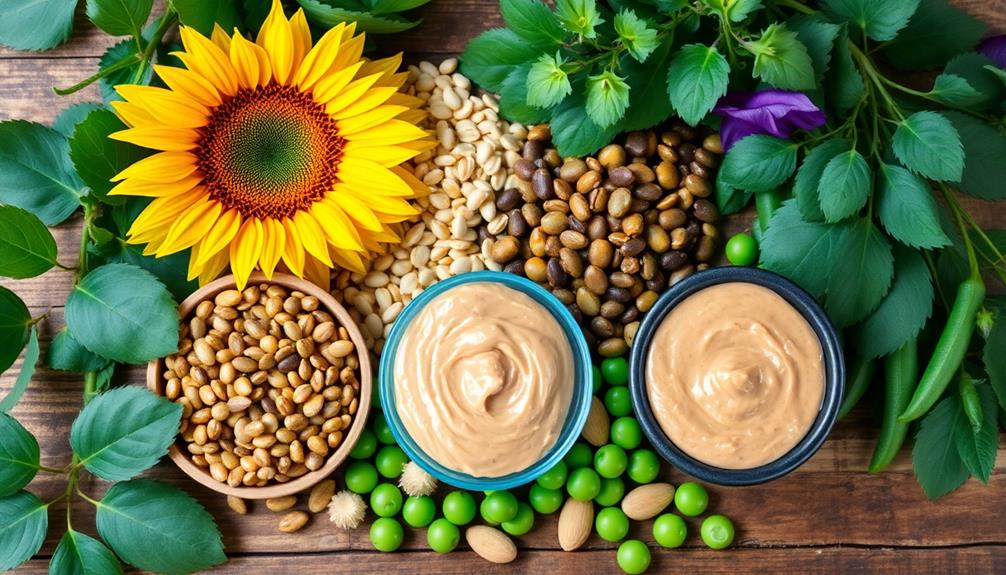
Raw vegan protein sources offer a diverse range of options that can meet your nutritional needs. When you adopt a raw vegan diet, it's important to include various protein sources to guarantee you're consuming all the necessary amino acids.
While legumes like lentils and chickpeas are excellent choices, nuts and seeds such as almonds and chia seeds also play a significant role. Chia seeds, in particular, are a complete protein source, containing all nine essential amino acids, making them a valuable addition to your diet. Whole grains like quinoa can be a fantastic addition too, providing necessary nutrients.
In a raw vegan diet, you can enhance your protein intake by opting for sprouted lentils and seeds, which are both highly digestible and nutrient-dense. Furthermore, don't overlook superfoods like spirulina; it's a complete protein, meaning it contains all nine essential amino acids critical for muscle growth and repair.
Including seeds like chia can also boost your omega-3 intake, which is beneficial for overall health and wellness the nutritional value of chia seeds.
Monitoring your protein intake is fundamental to prevent deficiencies and maintain a balanced diet rich in vitamins and minerals. By incorporating a variety of these raw vegan protein sources each day, you'll guarantee that you're not only meeting your protein needs but also enjoying a delicious and fulfilling diet.
High Protein Plant Foods
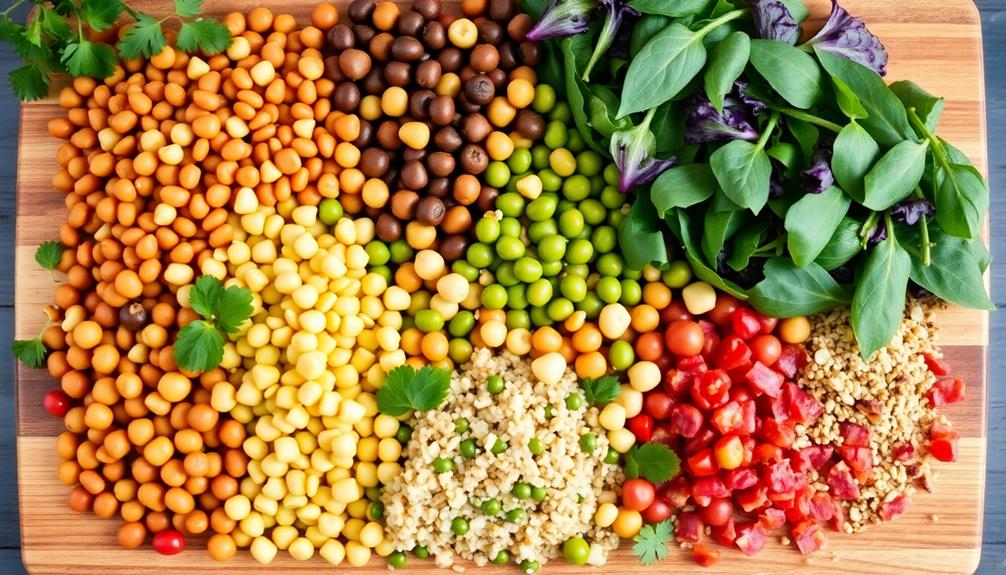
When it comes to incorporating protein into your diet, high-protein plant foods offer a variety of delicious options that can help you meet your nutritional goals.
Legumes like lentils, chickpeas, and black beans are fantastic sources of both protein and fiber, supporting muscle growth and aiding digestion. Additionally, many of these legumes contain folate, important for reducing neural tube defects, making them beneficial not just for overall health but also for pregnant women.
Nuts and seeds, especially almonds and chia seeds, provide healthy fats along with substantial protein, making them perfect for snacks or adding to meals.
Whole grains such as quinoa, farro, and brown rice not only deliver protein but also essential vitamins and minerals, contributing to a balanced diet.
Don't forget about leafy greens like spinach, kale, and broccoli; they contain protein as well as a wide range of micronutrients. Including these in your meals can enhance your overall protein intake.
If you're looking for convenience, consider plant-based protein powders derived from pea, rice, or hemp. These options easily boost the protein content in smoothies or other recipes, catering to diverse dietary needs.
Delicious Raw Recipe Ideas
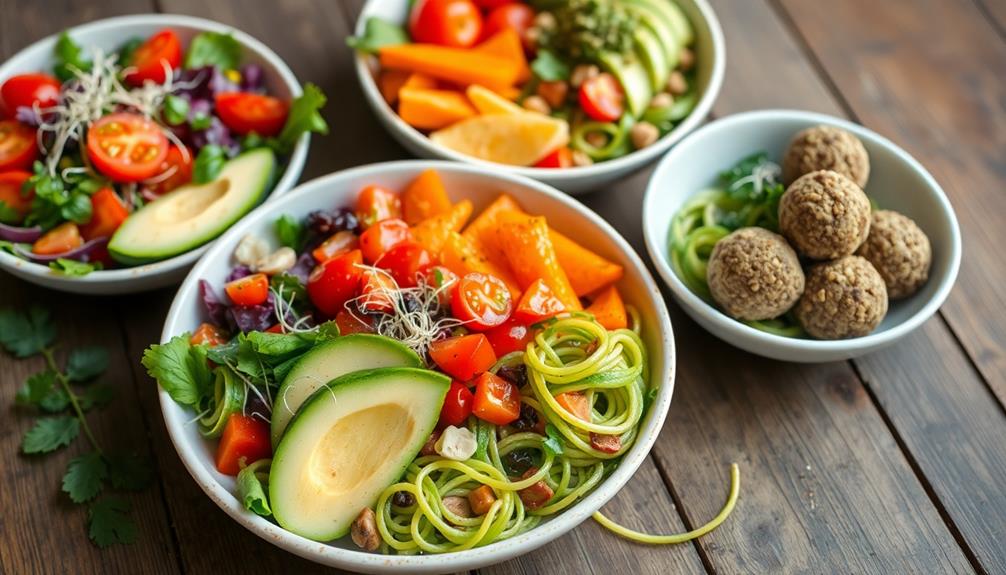
Explore a world of delicious raw recipes that not only tantalize your taste buds but also pack a protein punch. You can easily whip up high-protein raw vegan recipes that are nutritious and satisfying.
Start your day with a vibrant smoothie bowl featuring plant-based protein powder, leafy greens, and your favorite fruits. This invigorating breakfast not only energizes you but also fuels your muscles.
For snacks, consider making energy balls using dates, nuts, and superfoods like spirulina. These no-bake treats are quick to prepare and perfect for on-the-go munching.
When you're craving something savory, try raw hummus made from sprouted lentils. This protein-rich dip enhances nutrient absorption and pairs wonderfully with fresh veggies or raw crackers.
Don't forget about chia and hemp seeds! They're fantastic in puddings or blended into smoothies, adding a creamy texture while boosting your protein intake.
With these delicious raw recipe ideas, you can enjoy meals that nourish your body while keeping your taste buds happy. Embrace the joys of high-protein raw vegan recipes, and watch how easy it's to stay healthy without sacrificing flavor!
Nutritional Values of Recipes
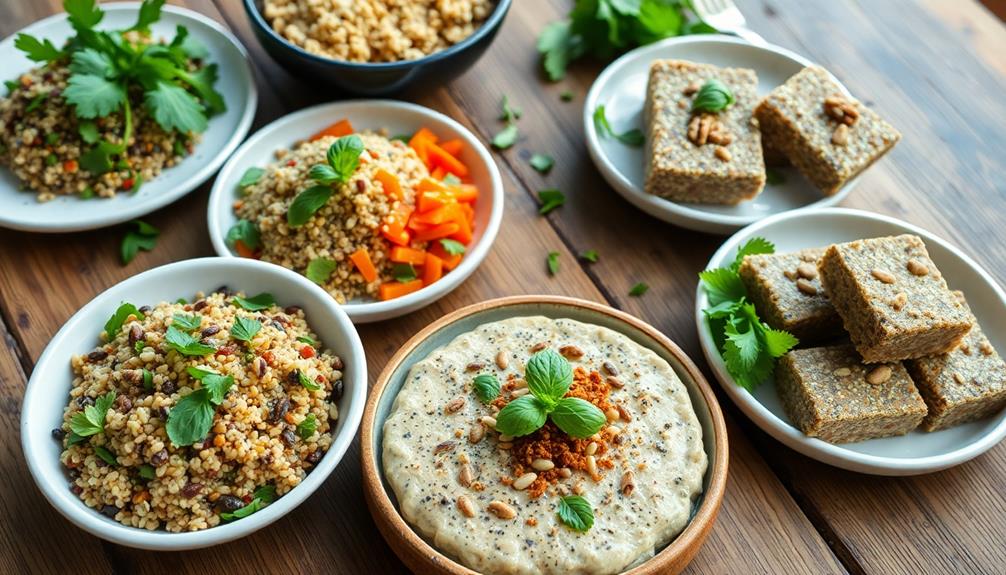
When you explore high-protein raw food recipes, you'll notice that each serving packs a punch with around 350 calories and a solid protein boost.
Incorporating a variety of protein-rich ingredients, such as nuts, seeds, and legumes, not only enhances flavor but also promotes overall health and wellness.
It's crucial to mix different protein sources, like nuts and seeds, to achieve nutritional balance without cooking.
This approach not only supports muscle repair but also guarantees you get a variety of nutrients your body needs, making it akin to how Montessori toys promote hands-on learning and exploration.
Protein Content Overview
Understanding the protein content of high-protein raw food recipes is essential for anyone looking to boost their nutrient intake while enjoying a plant-based diet. Most of these recipes pack around 350 calories per serving, focusing on nutrient density to support muscle growth and recovery.
By incorporating ingredients like chia seeds, hemp seeds, and spirulina, you can access complete proteins that deliver all essential amino acids necessary for peak health.
Sprouted lentils are another fantastic addition, enhancing protein content while improving nutrient absorption, making them ideal for a raw vegan diet. To guarantee you're getting a balanced intake of amino acids, mix various protein sources such as nuts, seeds, and legumes in your meals. This not only enriches your diet but also keeps your meals interesting.
What's great is that many high-protein raw food recipes can be whipped up in just 10 minutes, allowing you to enjoy substantial protein and nutrient benefits without spending much time in the kitchen.
Nutritional Balance Importance
Maintaining nutritional balance is fundamental for anyone following a raw vegan diet, especially when focusing on high-protein recipes. Each serving of these recipes typically contains around 350 calories, which contributes to a balanced energy intake. By keeping your serving size to 150 g, you can easily control portions and monitor your overall nutritional intake.
Incorporating diverse, wholesome ingredients not only enhances flavor but also guarantees you're getting a wide range of vitamins and minerals, which are essential for your health. High-protein plant foods like nuts, seeds, and legumes are significant as they provide essential amino acids necessary for muscle growth and repair. This variety helps mitigate the risk of deficiencies that can occur in raw vegan diets.
You should pay close attention to your daily protein intake. High-protein recipes can support your nutritional needs while keeping your meals exciting.
Meal Prep and Storage Tips
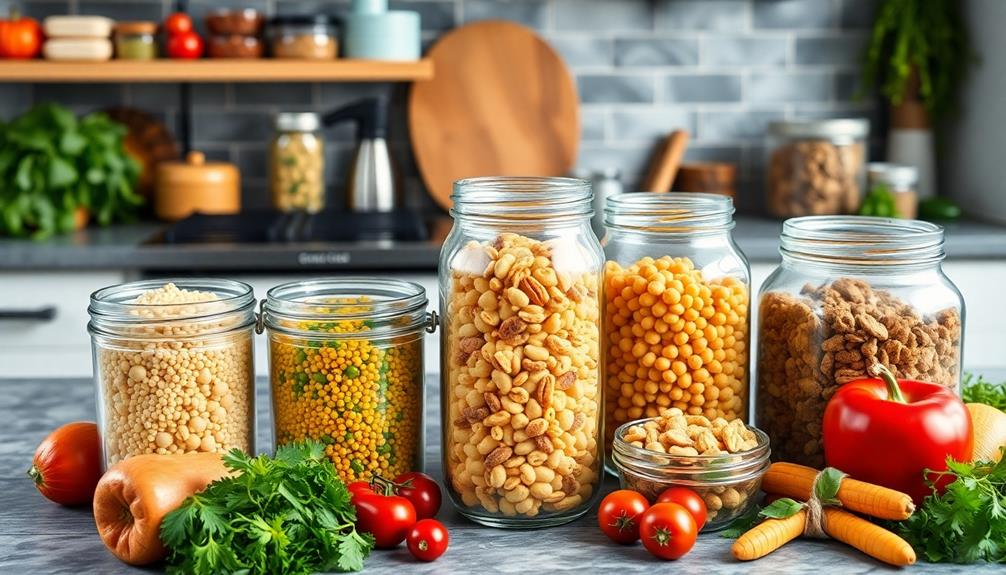
When it comes to meal prep, efficient storage solutions are key to keeping your high-protein raw food fresh.
You'll want to separate ingredients and store them in clear, labeled containers for easy access and visibility.
Following these tips will help you maximize flavor and preserve nutritional quality, reducing waste and ensuring you enjoy your meals at their best.
Efficient Storage Solutions
To keep your high-protein raw food recipes fresh and delicious, efficient storage solutions are crucial. Start by using air-tight containers for your meal preps. This minimizes airflow and helps maintain freshness for up to 2-3 days.
Label each container with preparation dates to track freshness and guarantee you consume your meals in a timely manner.
Portion your meals into individual servings. This makes it easy to grab nutritious snacks or meals on the go, guaranteeing you stay on track with your protein intake.
For specific high-protein recipes like sprouted lentil hummus or protein balls, store them in the refrigerator. Doing so not only enhances their flavor but also improves their texture over time.
If you want to extend the shelf life of certain meals or snacks, consider freezing them. Protein balls and chia puddings freeze well and provide quick options when you need something nutritious in a hurry.
Meal Prep Techniques
For successful meal prep of high-protein raw foods, it's essential to plan your sessions efficiently. Implementing effective meal prep techniques can save you time and guarantee you always have nutritious options on hand. Here are some strategies to get you started:
- Prepare ingredients in bulk: Soak nuts or sprout lentils to have versatile components ready for various recipes.
- Use clear containers: They promote easy visibility, encouraging quick access to your meals and reducing food waste.
- Label everything: Mark containers with preparation and expiration dates to manage freshness.
When you prep your meals, think about incorporating protein powder into your recipes for an added protein boost. This can be a game-changer, especially if you're looking to meet specific nutritional goals.
Remember to store your high-protein raw meals in air-tight containers, and try to consume them within 2-3 days. Planning weekly sessions allows you to create a diverse array of dishes while rotating ingredients to prevent spoilage.
With these meal prep techniques, you'll enjoy a healthy, vibrant diet without the stress of last-minute cooking.
Freshness Preservation Tips
Maintaining the freshness of your high-protein raw meals is key to enjoying their full flavor and nutritional benefits. Here are some effective freshness preservation tips to keep your meals vibrant and delicious.
- Store your raw vegan meals in air-tight containers to limit airflow, allowing them to stay fresh for up to 2-3 days.
- Prepare meals in small batches to guarantee peak freshness and to minimize spoilage before you get to enjoy them.
- Use seasonal ingredients to enhance the flavor and nutritional value of your dishes.
- Always refrigerate prepared meals immediately after cooking to slow down ingredient degradation and retain taste and texture.
To help you remember these tips, refer to the table below:
| Tip | Purpose |
|---|---|
| Use air-tight containers | Limits airflow, prolongs freshness |
| Prepare small batches | Prevents spoilage, maintains quality |
| Choose seasonal ingredients | Maximizes flavor and nutrition |
| Refrigerate immediately | Slows degradation, keeps meals tasty |
Health Benefits of Raw Diet
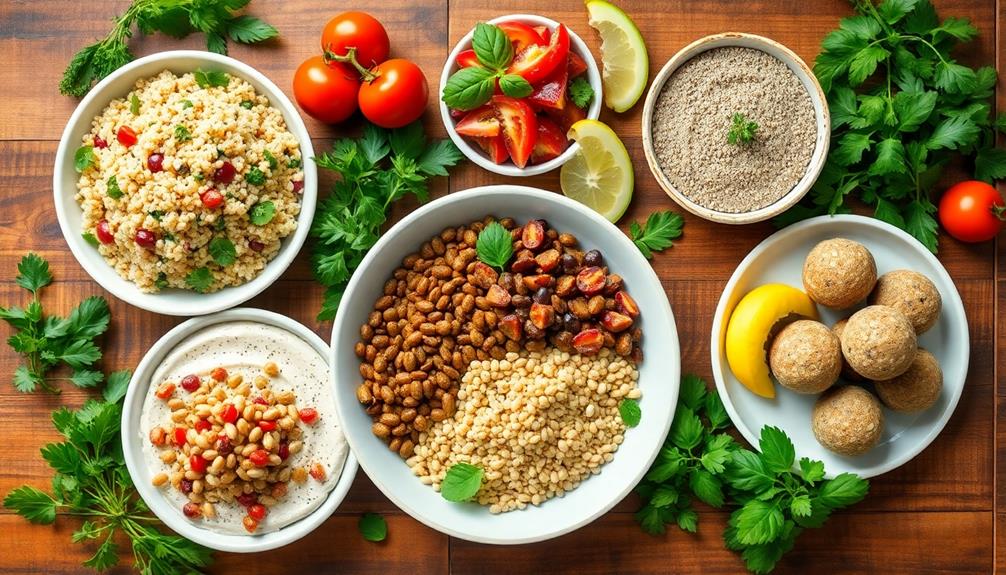
A raw vegan diet offers numerous health benefits that can enhance your overall well-being. By focusing on fresh fruits, vegetables, and nutrient-rich foods like hemp seeds, you're likely to experience significant improvements in your health.
- Improved Digestion: The high fiber content in raw foods helps to promote healthy digestion, making you feel lighter and more energized.
- Enhanced Nutrient Absorption: Raw foods retain more vitamins and minerals compared to cooked options, giving your body the nutrients it craves for optimal performance.
- Weight Loss Support: With fewer calories and higher water content, a raw vegan diet can assist in shedding unwanted pounds without deprivation.
Additionally, this diet is rich in antioxidants from fresh produce, which can reduce inflammation and lower the risk of chronic diseases such as heart disease and diabetes.
The emphasis on whole foods free from additives supports your body's natural detoxification processes. By adopting a raw vegan lifestyle, you're not just making a dietary change; you're embracing a healthier, more vibrant way of living.
Community and Support Resources
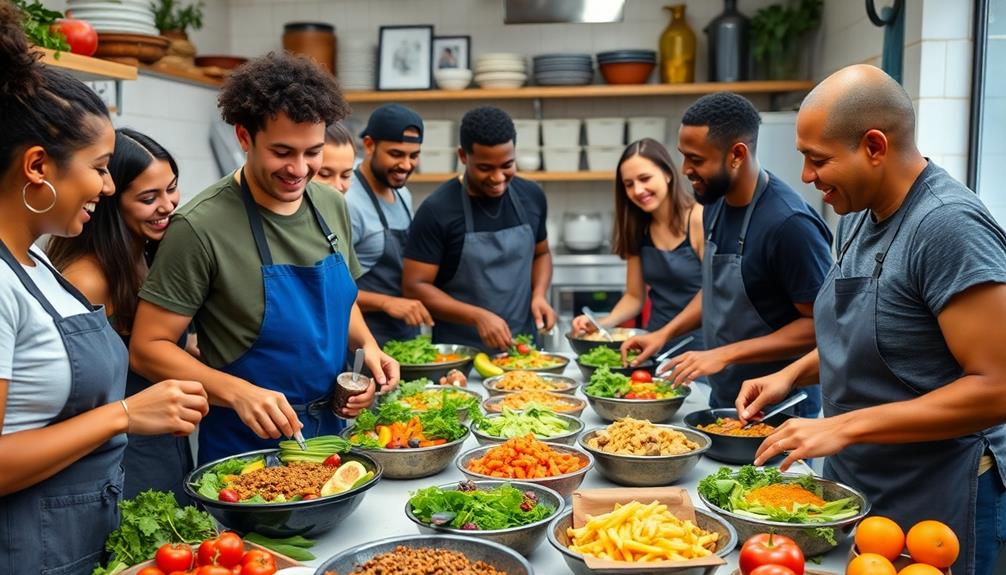
Embracing a raw vegan diet can be a fulfilling journey, but finding the right support makes all the difference. Community groups and forums are excellent resources for anyone adapting to this lifestyle. They offer recipe ideas, nutritional advice, and a platform to ask questions.
Social media platforms like Instagram and Facebook host vibrant communities where you can share your experiences, adaptations, and feedback on high-protein raw food recipes.
Don't underestimate the power of online resources. Numerous websites and blogs focus specifically on raw vegan diets, featuring insightful articles, tips, and personal stories that can motivate you.
Online video tutorials and cooking classes also provide visual guidance, helping you learn new techniques and recipes for high-protein raw meals.
If you prefer face-to-face interaction, consider local meetups and workshops. These events can foster connections and create support networks among those interested in the raw vegan diet.
You'll find that sharing learnings and participating in communal meal prepping can greatly enhance your experience. Remember, connecting with others on this journey can make your adjustment smoother and more enjoyable.
Frequently Asked Questions
What Raw Food Has the Most Protein?
When you're searching for the raw food with the most protein, consider spirulina. It packs about 57 grams of protein per 100 grams, making it a top choice for boosting your protein intake effectively.
How to Get Protein in a Raw Food Diet?
You'll feast on a protein-packed treasure trove! Immerse yourself in vibrant legumes, crunchy nuts, and hearty grains. Blend plant-based powders into smoothies or snack on energy balls to supercharge your day with raw protein goodness.
What Protein Can You Eat Raw?
You can enjoy raw protein sources like sprouted lentils, chickpeas, nuts, seeds, and leafy greens. Incorporating these into your meals boosts your protein intake while keeping your diet fresh and nutritious.
How to Get 140G of Protein a Day Vegan?
You might think it's tough to hit 140g of protein on a vegan diet, but by mixing lentils, beans, nuts, seeds, whole grains, and protein powders, you can easily reach your goal while enjoying delicious meals.
Conclusion
Incorporating high-protein raw food recipes into your diet can transform your meals into culinary masterpieces bursting with flavor and nutrition. You'll feel like a superhero as you nourish your body with vibrant, plant-based ingredients. With endless recipe ideas and tips for meal prep, you're well-equipped to enjoy this delicious lifestyle. Embrace the health benefits and connect with a supportive community that shares your passion for raw food. Immerse yourself, and let your taste buds experience the magic!

